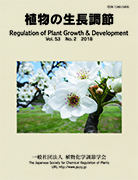53 巻, 2 号
選択された号の論文の13件中1~13を表示しています
- |<
- <
- 1
- >
- >|
特集
-
原稿種別: 特集
2018 年 53 巻 2 号 p. 91-92
発行日: 2018年
公開日: 2018/12/28
PDF形式でダウンロード (346K) -
原稿種別: 特集
2018 年 53 巻 2 号 p. 93-97
発行日: 2018年
公開日: 2018/12/28
PDF形式でダウンロード (2115K) -
原稿種別: 特集
2018 年 53 巻 2 号 p. 98-101
発行日: 2018年
公開日: 2018/12/28
PDF形式でダウンロード (1061K) -
原稿種別: 特集
2018 年 53 巻 2 号 p. 102-108
発行日: 2018年
公開日: 2018/12/28
PDF形式でダウンロード (1816K) -
原稿種別: 特集
2018 年 53 巻 2 号 p. 109-115
発行日: 2018年
公開日: 2018/12/28
PDF形式でダウンロード (1490K)
総説
-
原稿種別: 総説
2018 年 53 巻 2 号 p. 116-123
発行日: 2018年
公開日: 2018/12/28
PDF形式でダウンロード (1587K) -
原稿種別: 総説
2018 年 53 巻 2 号 p. 124-130
発行日: 2018年
公開日: 2018/12/28
PDF形式でダウンロード (2185K) -
原稿種別: 総説
2018 年 53 巻 2 号 p. 131-138
発行日: 2018年
公開日: 2018/12/28
PDF形式でダウンロード (1518K)
研究ノート
-
原稿種別: 研究ノート
2018 年 53 巻 2 号 p. 139-145
発行日: 2018年
公開日: 2018/12/28
PDF形式でダウンロード (1278K) -
原稿種別: 研究ノート
2018 年 53 巻 2 号 p. 146-151
発行日: 2018年
公開日: 2018/12/28
PDF形式でダウンロード (1578K)
談話室
-
原稿種別: 談話室
2018 年 53 巻 2 号 p. 152-154
発行日: 2018年
公開日: 2018/12/28
PDF形式でダウンロード (2117K) -
原稿種別: 談話室
2018 年 53 巻 2 号 p. 155-156
発行日: 2018年
公開日: 2018/12/28
PDF形式でダウンロード (1183K)
学会記事
-
原稿種別: 学会記事
2018 年 53 巻 2 号 p. 157-158
発行日: 2018年
公開日: 2018/12/28
PDF形式でダウンロード (360K)
- |<
- <
- 1
- >
- >|
